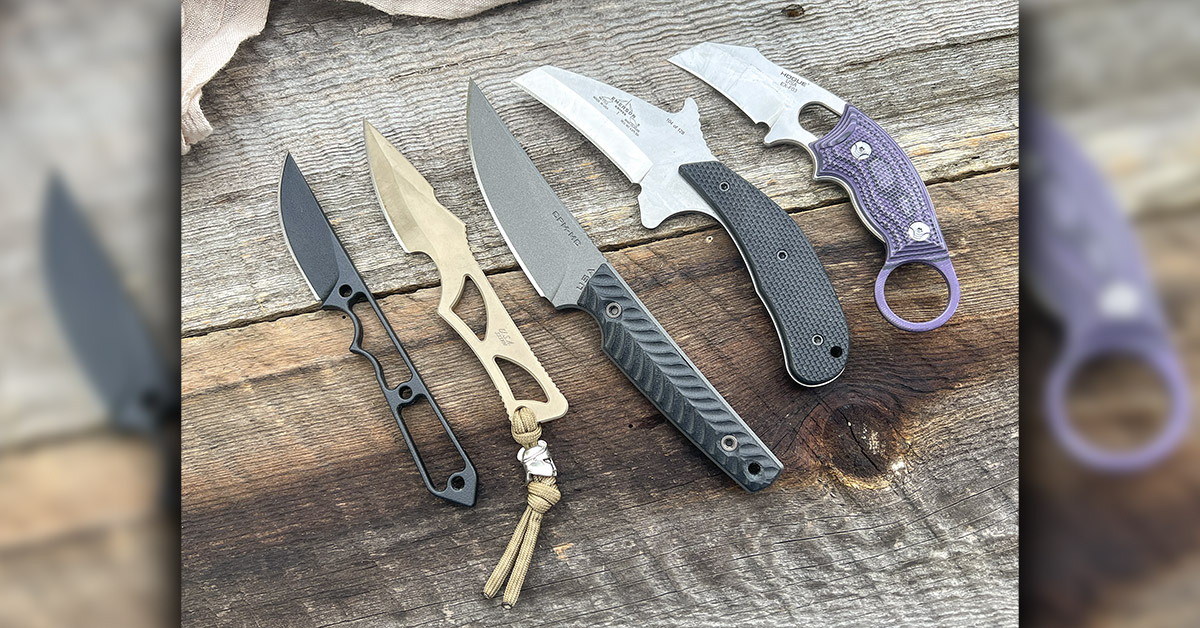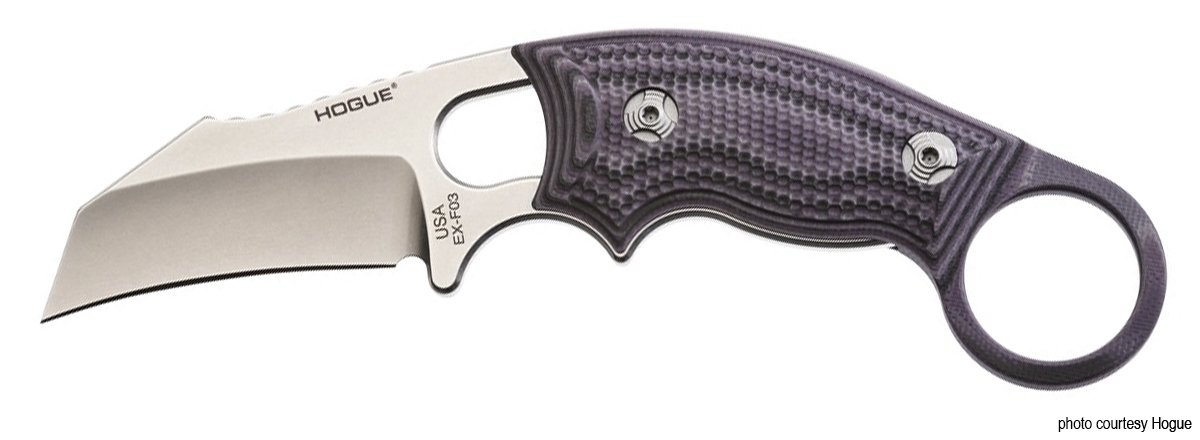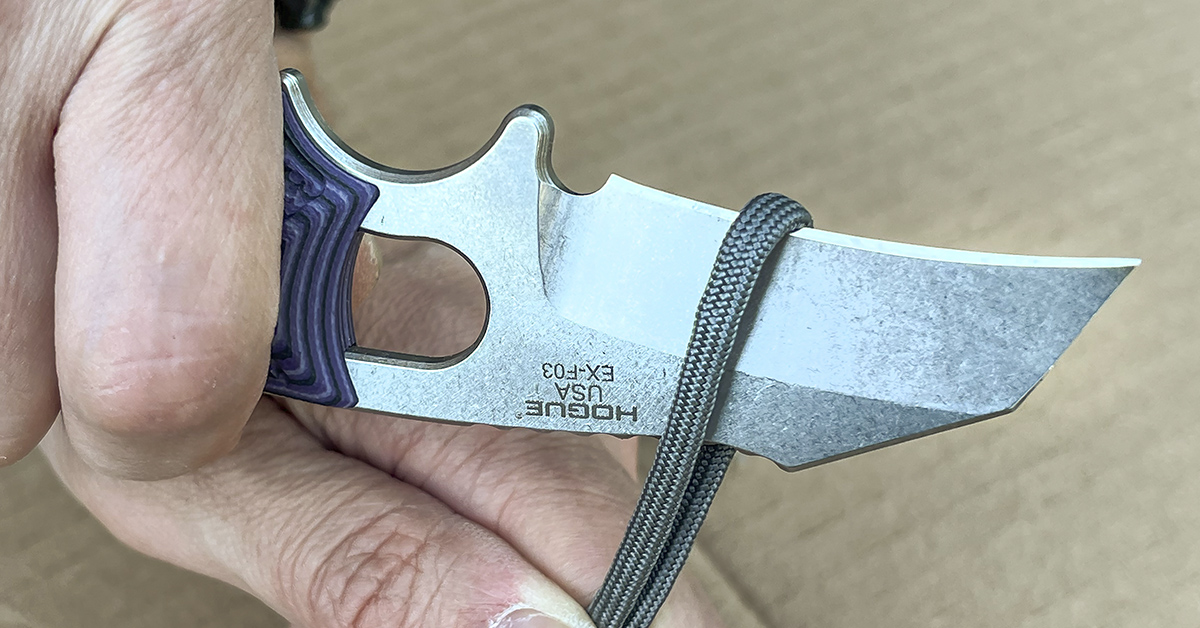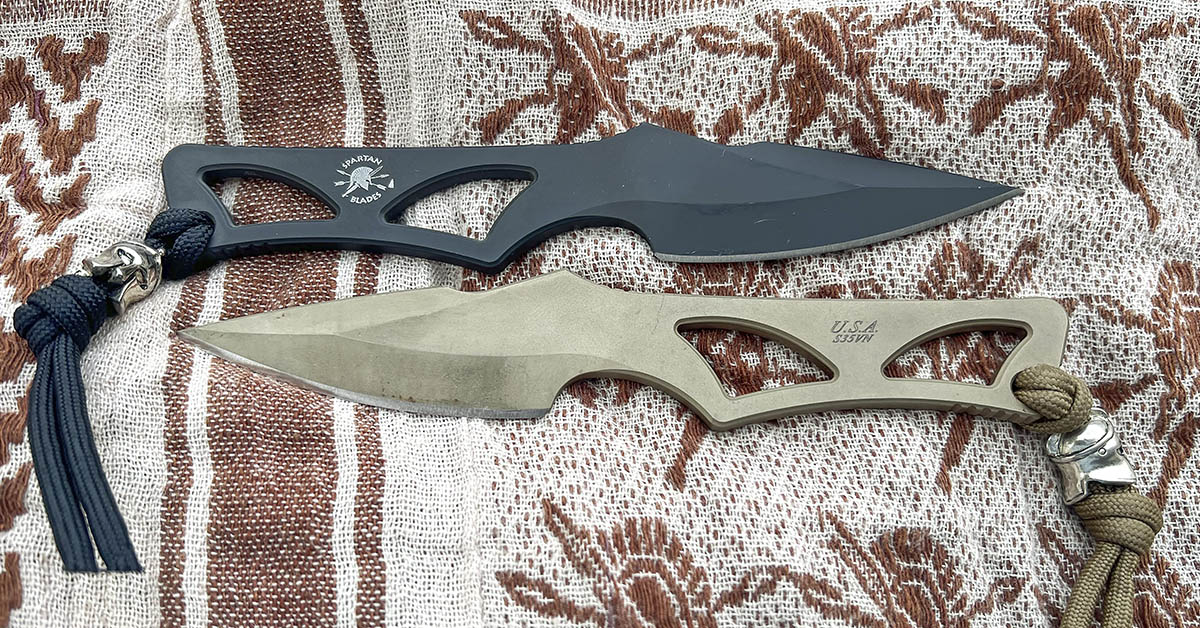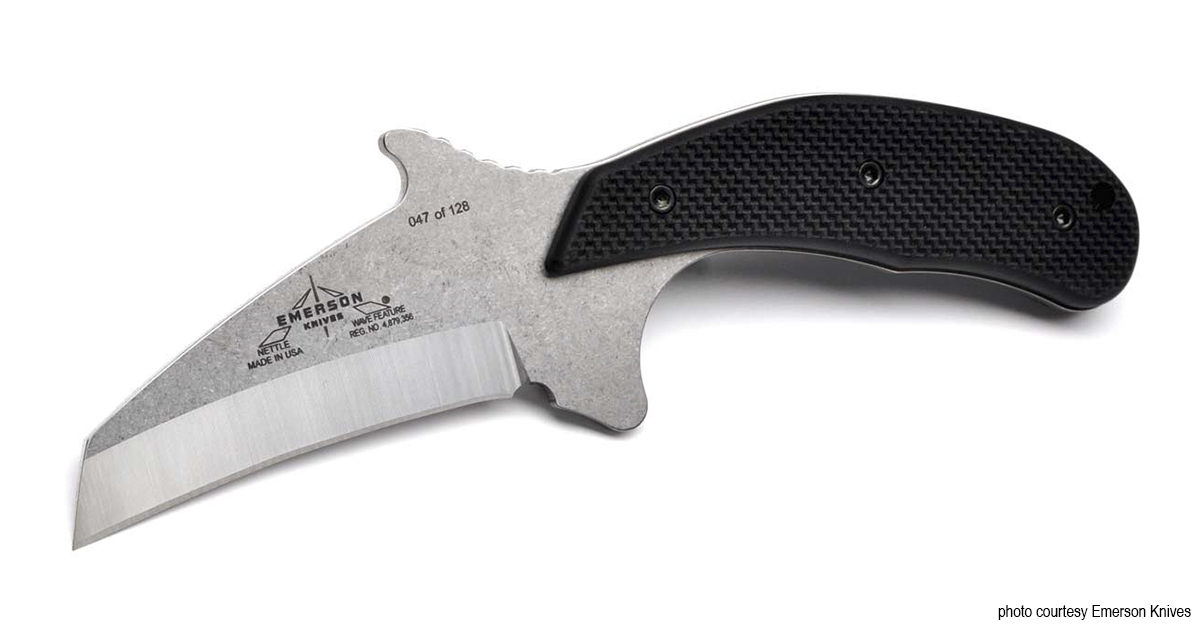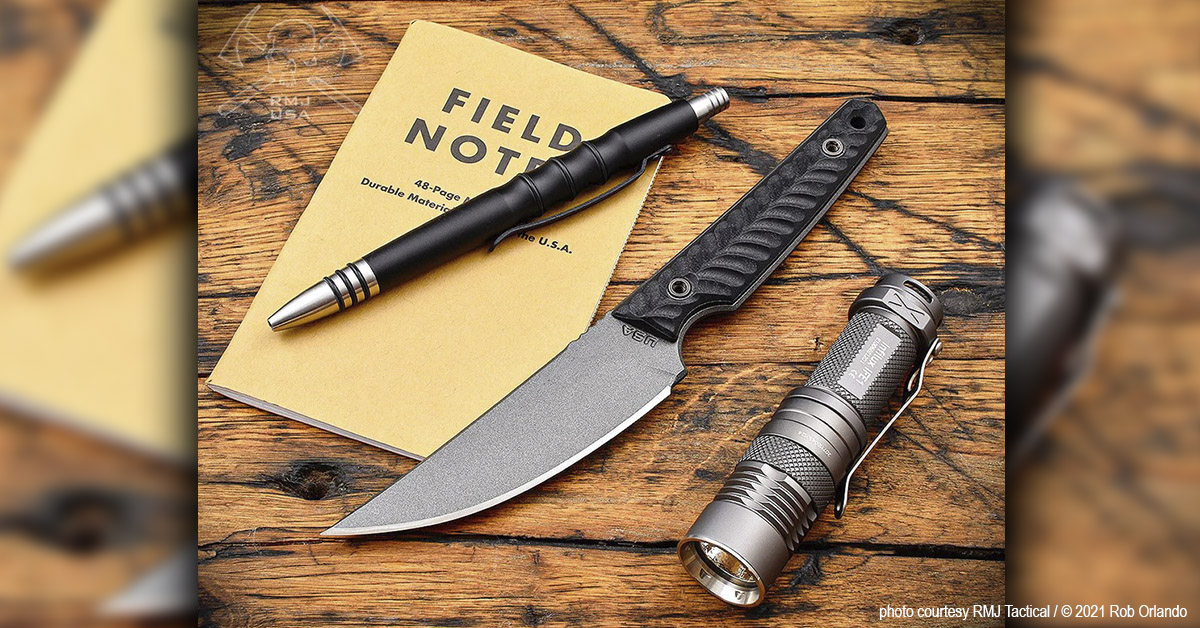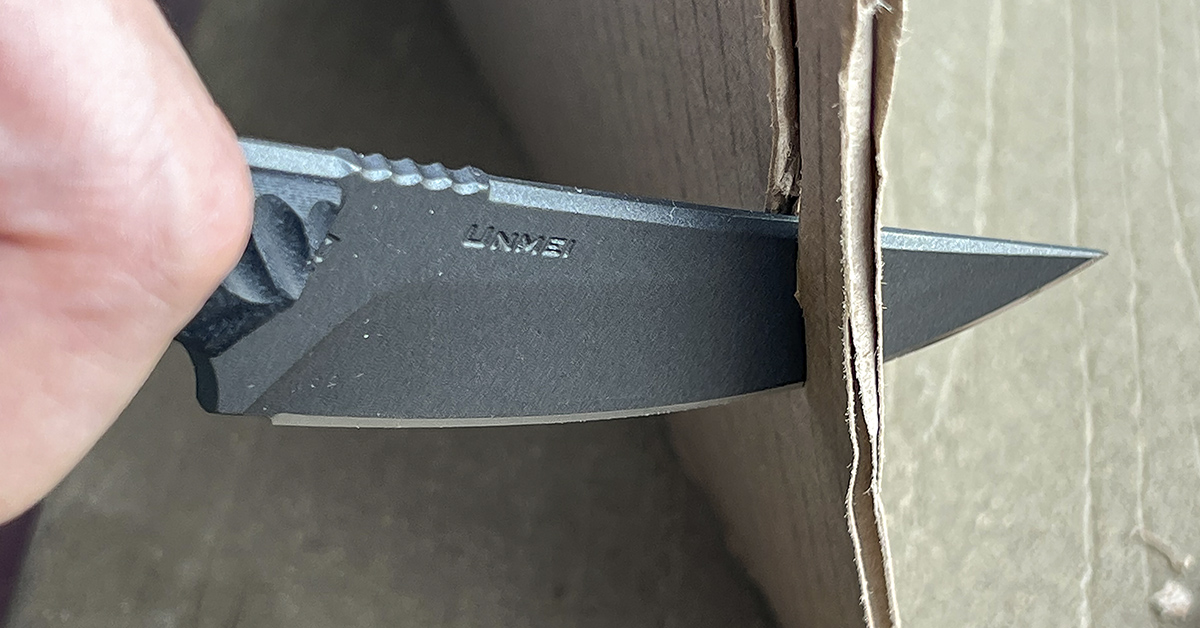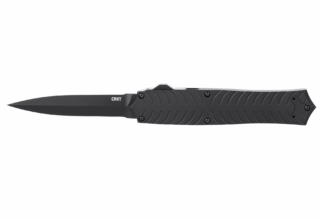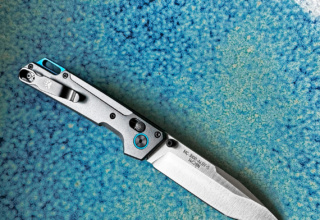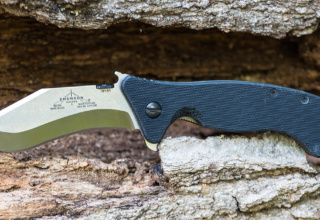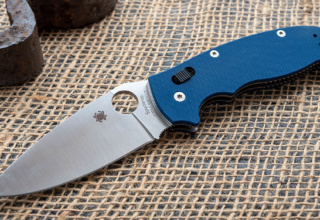Folders may be the “current thing,” but quick deployment and no-fail performance in an easy-to-carry platform is possible with these EDC fixed-blade knives
by Dexter Ewing; photos by Marty Stanfield, Marty Stanfield Photography (except where noted)
Most of us opt for some sort of folding knife for our daily carry needs. Slipjoints, liner locks, lockbacks, or any one of the folders using new technology blade locks are top choices. Folding knives are convenient to carry, either by carrying them in the bottom of the pocket or by making use of the included pocket clip to carry the knife clipped securely to the inside of the pants pocket.
But there are some knife guys who prefer to everyday carry (EDC) a small fixed blade in lieu of a folder. Some say they want the knife to be used as both a self-defense tool as well as a utility cutting tool. When you carry a small fixed blade once, you free it of the sheath and the knife is instantaneously ready for use. No fumbling to open the blade under duress, such as in a self-defense situation, or trying to open the blade while you are holding onto something.
If you have not considered carrying a fixed blade on an EDC basis (or have thought about doing so but haven’t committed to it), we will take a look at several options to consider for EDC fixed blades. Keep in mind that the knives we discuss here are just some we have selected. There are plenty others like them on the market. The thing to remember here is the overall size of the fixed blades. They must be short enough to carry comfortably but large enough to provide a solid grip for your hand as well as have a blade large enough to be effective for both utilitarian and self-defense purposes. In other words, the optimal EDC fixed blades should not be too large in overall length because at some point they will be rather cumbersome to carry.
TOPS Street Spike
Those who know fixed blades are familiar with TOPS Knives out of Ucon, Idaho. They manufacture a myriad of fixed-blade designs for outdoor, tactical, and EDC use. The knives are not flashy, but they are 100% working knives and are built for the long haul. Their Street Spike model represents a minimalist fixed-blade design with a skeletonized handle and a drop point blade. There are no handle scales in order to keep the profile of the knife as slender as possible and the price minimal.
Starting with 1095 carbon steel — a steel that is widely found in a lot of TOPS models and is known for its cost efficiency and ease of resharpening in the field — the blade is 2.75 inches long and overall length is 6.75 inches. The Street Spike is given a black epoxy coating as a layer of protection against corrosion (1095 is not stainless steel) and for enhanced grip traction.
The handle of the Street Spike features two finger grooves — a prominent one for your index finger and a minor one for your middle finger. The rest of your fingers wrap naturally around the handle. Despite not having handle scales, you will find the grip surprisingly comfortable and secure.
The Street Spike was designed as both a backup weapon and a working knife. It can be used in the kitchen, garage, or anywhere your travels take you. The drop point blade presents ample belly for most cutting chores. It’s easy to use and surprisingly effective in its compact form. For a compact fixed blade, the Street Spike is quite thick, featuring ¼-inch stock. This is also key to the handle being as comfortable as it is in the hand without handle scales. The thickness also provides the knife its lateral strength and the blade tip is reinforced for strength as well. Simply put, the Street Spike is a tough small blade — probably one of the smallest blades with such big attitude.
Each Street Spike comes with a mixed Kydex sheath and two belt loops that attach the sheath to the belt in the horizontal carry position. If you are right-handed, wear the sheath on your left front side so all you do is reach around with your right hand and grab the handle and pull. For left handers, you will need to flip the belt loops so the sheath mounts in the opposite manner and use your left hand. If you wish, the belt loops can be removed with a Phillips head screwdriver and a ball chain necklace threaded through the two holes at the end of the sheath for carry as a neck knife. Neck knife carry is possible underneath a regular T-shirt, a polo shirt, or a button-down dress shirt. It’s easily concealed and only you know it is there. When called into action, reach up under the shirt and feel for the handle. Grasp firmly and tug. The knife comes free of its sheath and is ready for action.
Neck carry is what I prefer with the Street Spike, and it is not too heavy to carry in this manner. There is plenty of retention on the sheath to keep the knife from falling out on its own. With an MSRP of $129.95, the TOPS Street Spike is a good value.
HOGUE EX-F03 Hawkbill
Hogue Knives offers a stylish EDC fixed blade in the form of their EX-F03 model. Designed by custom knifemaker Allen Elishewitz, the EX-F03 comes in two blade styles: clip point and hawkbill. The clip point is straightforward while the hawkbill’s curve makes the knife like one’s own personal claw. The hawkbill looks more formidable and aggressive, and that’s what Hogue sent us for review for this article.
The EX-F03 Hawkbill came with purple G-Mascus G-10 handles — an interesting twist since most tactical knives have black handles. The surface of the G-Mascus handles is given a tight dimpled finish like that of a golf ball. The purpose of this is to provide a non-slip grip. This texturing also looks pretty cool. The handle scales are attached to the tang using two sets of Torx-head screws.
The blade’s 2.25-inch length is short, but it is still effective at cutting. Material of choice for the blade is 154CM stainless steel, which offers good edge retention and is easy to sharpen.
With an overall length of 6.5 inches, the EX-F03 Hawkbill carries well either on the belt or as a neck knife. A stonewash treatment provides a good, sealed finish and eliminates the tiny pores on steel that could allow corrosion to set in. The ergonomic-shaped handle has a prominent finger groove to help index your grip, and the rest of the fingers fall nicely in place after that.
On the blade spine, you will find a run of traction notches that accommodates the thumb or index finger to aid in applying pressure to the cut or to provide additional stability and control when needed. The integral finger ring is borrowed from the karambit and provides your pinky a place to grip when grasping the whole handle in your hand. The finger ring also acts as a retention point. By sticking your pinky though the finger ring and wrapping the other fingers around the handle, you will have a secure grip. You can press the handle into your palm using the pinky, ring, and middle fingers and release the index finger and thumb from the handle. This lets you use the thumb and index fingers to grab items without setting the knife down. When you want to cut again, just bring the index finger and thumb back onto the handle and continue.
The hawkbill blade shape makes pull cuts super easy. The curvature of the cutting edge helps to feed the material being cut into the blade. Additionally, the point of the tip makes scoring materials a cinch. Grasp the handle tightly and land your index finger on the notched blade spine. You can both apply pressure to the blade as well as have excellent control of the blade. The pull cuts help to slice cardboard, plastic sheeting, and landscape fabric, among other things. The dimple textured G-Mascus handle makes the grip comfortable and secure. The handle’s various curves help to seat the fingers comfortably.
While the EX-F03 Hawkbill was designed as a tactical knife, this knife certainly can work when necessary. The knife also feels great in reverse grip. Those who are trained in knife combat with this grip will be pleasantly surprised.
As far as sheaths go, the EX-F03 ships with two of them. The first is a dedicated belt sheath made of molded reinforced thermoplastic. It has a rotating belt attachment that indexes at several different points to carry the knife vertically, horizontally, or canted. The only issue is that there is a belt size limit that can be used with this sheath. If you like wearing wider belts, you cannot use this sheath, but that doesn’t mean you are out of luck. You can take the second included Boltaron neck sheath and affix a Blade-Tech Tek-Lok (not included) to the holes in the sheath and wear the knife in this manner.
Another way of wearing the EX-F03 is neck carry with the Boltaron sheath. It is set up to carry the knife right-handed or left-handed. A length of paracord is included to carry the knife on your body. It is recommended to wear the knife by putting the paracord over one of your arms and then slip it over your head. This carries the knife at an angle and requires a cross-draw method to unsheath. Both sheaths are constructed very well and hold the knife securely. MSRP for this USA-made knife is $159.95.
Spartan Blades Enyo
Another popular EDC-style fixed blade is the Spartan Blades Enyo. The smallest of the Spartan fixed blade line, the Enyo features a highly ergonomic handle design paired with a spear point blade of just over two inches in length. Designed to be carried inside the waistband (IWB) or neck carry, the Enyo has what it takes to serve as a backup weapon or a highly functional compact cutting tool.
Starting with premium CPM S45VN stainless steel, the Enyo has the horsepower to go the distance with hard use. With an overall length of 6 ¼ inches, this knife can also be easily carried in a deep pocket. Neck carry works especially well.
In-hand, the Enyo features a prominent finger recess that seats the index finger, and the rest of the fingers fall into place on the remainder of the handle to form a tight grip. There is an indentation on the blade spine that serves as a secure thumb rest to help apply pressure to the blade and to increase control during precise cutting tasks. There are several locations on the handle that sport traction notches to assist further in a non-slip grip. Two stylish cutouts in the handle serve to lessen the weight of the knife.
The Enyo is a perfect example of a daily carry fixed blade that has the strong possibility of replacing a folding knife as a prime EDC candidate. It will do a lot of the same cutting tasks that you would reserve for a smaller lockblade folder. Available in all-black PVD or FDE PVD coating, either version looks great and would serve well as a daily companion.
Carrying the Enyo is just as easy as putting it to use. Each version comes with a corresponding color Kydex sheath. The blade snaps right in for an ultra-secure carry under a shirt or dropped to the bottom of the pocket. The skeletonized nature of the handle allows for a very flat profile that doesn’t print under a shirt for maximum concealment. Each sheath is well made, just like the knife.
The Enyo is perfect for those everyday cutting chores. S45VN is one of the best blade steels on the market now and it is well known for its extreme edge-holding ability.
I would advise that instead of letting the blade go completely dull and then resharpening, to do more frequent honing to keep up the edge. Frequent honing saves the hassle of trying to resharpen a totally dull blade, which can be a pain.
The Enyo is an ideal size and has a comfortable handle shape, and it is thick enough to withstand heavy use, although I found the blade to be a bit too thick for certain finer cutting tasks, such as cutting cardboard. The knife will go through, but you must exert a bit more effort to make the cut. This is due to the way the blade is ground. The flat grind portion is a bit of a wedge; however, the Enyo could also be used as a last-ditch self-defense tool and for this, the blade geometry yields a strong blade design. The false edge reduces drag upon penetration of thick materials, making it ideal for a backup edged weapon that is totally concealable. While it can take on working tasks and do so just fine, I feel there are other blades that work better for general cutting tasks.
If you are looking for a high concealable fixed blade for use as a self-defense tool, the Spartan Blades Enyo is the one you want.
Emerson Nettle
While primarily known for their tactical folders, Emerson Knives also manufactures a line of impressive tactical fixed blades such as the Nettle. The Emerson website bills it as “the size of a folder with the punch of a fixed blade.”
The Nettle measures a little over 7 inches overall, which is about the size of an opened folder. The blade length is 3 inches — big enough for most cutting jobs, not too small as to be ineffective.
The steel of choice is 154CM stainless steel — a USA-made steel that has very good edge holding properties and is fairly easy to resharpen. It has long been the standard steel of choice by Emerson Knives in all their knives, as well as a steel that many knife companies use as one of their “go-to” steels.
As with all Emerson Knives, the blade is double ground (ground on both sides) but sharpened only on one side (like a chisel-grind tanto). This is a hybrid-type blade execution, with a single cutting edge bevel that makes the knife easier to maintain since there is only one side to sharpen. This also makes the edge sharper.
The blade shape itself is interesting and looks unique. Its basic shape is a sheepsfoot blade but with a bit of a curve thrown in. You could say it’s a mix between hawkbill and sheepsfoot. The slight curve of the cutting edge helps to feed the material being cut and to channel the cutting power. There’s also a tip, formed by the start of the cutting edge and the sloped nose of the blade. This knife can take on scoring jobs like a boss!
Unlike most fixed blades of this size, the Nettle blade features integral upper and lower hand guards to prevent the hand from sliding forward during heavy use. The notched thumb ramp provides a secure place for your thumb to ride and the lower guard aids in choking up your grip on the handle for more cutting power or for precise control when needed. The forward rake of both hand guards, along with the ergonomic handle shape, gives the knife an aggressive stance in appearance.
The handle is a full tang construction with coarsely textured G-10 scales that provide excellent all-weather grip. Three pairs of hex head screws fasten the G-10 to the tang.
The blade can be employed in similar manner as you would a hawkbill, using a pulling motion for cutting. Some push cuts can be done as well, but I feel that the most power you can obtain from the knife is when pull cuts are employed. So, with materials like plastic sheeting, landscape fabric, cardboard, corrugated plastic sheets, and the like, all are easy to tackle with the Nettle. For any sort of cutting or slicing task that you need to do on a flat surface, such as a cutting board, the blade design of the Nettle works against this. The inward curve of the cutting edge prevents any part of it from contacting the flat surface. If you are doing a lot of cutting on a flat surface, then the Nettle is not for you.
Also, the double guards, while they are an increase in the safety factor, can be a hindrance as well. Depending on the situation, the guards may get in the way of whatever is being cut and hang up on things. I discovered that the lower guard can be used as a rest/pivot point when cutting on a flat surface. This comes in handy when cutting hose. Rest the guard on the edge of a hard surface and manipulate the hose and blade to cut down into the hose, pivoting the knife on the lower guard. This adds stability to the cut and offers better control of the knife.
The 154CM that Emerson uses is optimally heat treated. Of all the Emerson Knives I have used, I have been consistently pleased with the performance of 154CM, and the Nettle is no different.
When it comes to carrying the Nettle around, each knife is supplied with a custom molded Kydex sheath. The holes of the sheath work with a Blade Tech Tek-Lok belt attachment (Tek-Lok not included with the knife). There isn’t any sort of included belt attachment with the sheath. I believe this is done to allow the user to select his or her own method of belt attachment. The sheath locks up around the upper and lower hand guards of the knife, so there is no chance that the knife will pop out of the sheath on its own.
So, if you are in the mood for a tactical fixed blade that is a little different, look at the Nettle to add to your arsenal. Another interesting fact is the Nettle is a part of Emerson Knives’ Signature Series knife line. Every knife in the Signature Series is hand-signed by company founder Ernest Emerson with an engraver. His signature can be seen on the flat of the right side of the blade. Made in the USA, the Nettle carries an MSRP of $278.95.
RMJ Tactical Unmei
RMJ Tactical is a widely recognized name in high-end fixed blades for daily carry, tactical, and outdoors applications. They also make the best production tomahawks you will find anywhere this side of custom made. RMJ has a solid line of EDC fixed blades that have a variety of blade shapes for various tasks.
Their Unmei is a Japanese-inspired fixed blade that can serve multiple roles well, be it a tactical fixed blade, EDC fixed blade for utility and defense, or just general cutting use. Its design is known as a Kwaiken. This particular design dates back to the feudal era in Japan, where the Kwaiken was carried as an everyday pocketknife by the Samurai warriors. The shorter blade design was used as a utility knife — kind of like how we use a standard pocketknife today.
The RMJ Tactical Unmei’s 4-inch-long upswept blade can be a devastatingly effective slicing tool. The gentle curvature of the cutting edge powers easily through your toughest cutting chores and can handle lighter duty tasks that require finesse, such as kitchen work for meal prep.
RMJ typically uses high performance stainless steel for their knives, and they chose to use CPM Magnacut for this particular run of Unmeis. Magnacut is currently the top dog in stainless steel. It offers unprecedented edge holding ability, so the edge won’t peter out prematurely. It is fitting that this steel is used on the Unmei, given its versatility in many different settings. A tungsten Cerakote coating on the blade gives it a bit of contrast to the handle colors and an extra layer of corrosion protection.
As far as the handle goes, there is a finger choil in which your index finger wraps around, indexing your grip. The handle is around 4 inches long with a gentle taper towards the end. The handle material used is 3D machined G-10 with a milled-in series of grooves that work very well for providing hand traction without being overly aggressive. The Unmei comes in several colors of G-10: solid black, dirty olive (alternating layers of green and black G-10), and hyena brown. Extra handle scales are available for purchase at additional cost on the RMJ Tactical website.
The grip quality is excellent and inspires user confidence. The G-10 texturing works well with wet or dry hands. Carrying the Unmei is just as excellent as the performance of the knife. Each comes with a molded Kydex sheath and two MAD straps that allow scout carry (horizontal belt carry) or IWB (inside waist band). I found that IWB carry is best for me, wearing it on the right front side of my torso, with a single MAD strap looped around my belt. Wearing my shirt untucked, the knife doesn’t print, and you cannot tell that there’s a fixed blade under there. Easy access. Just reach under your shirt, grab the handle, and pull. The Unmei comes right out with no problem. It is lightweight enough to not weigh you down and this is one of the best things about this knife — it is slim, lightweight, and very sharp.
The Unmei is all business. It slices efficiently with no wasted motion. It will eat cardboard and thicker plastic for breakfast. The factory edge is extremely sharp and doesn’t hesitate in handling tough cutting jobs. If you are looking for an easy-to-carry and highly durable fixed blade for utility cutting chores in the garage or around the yard, this is it.
I also found great pleasure in employing the Unmei in the kitchen as a utility knife for processing fruits, vegetables, and meat. While I would not use it for the cutting reserved for larger kitchen knives, I have no hesitation using it for general slicing and processing work. Even with wet hands, I never had to worry about the grip quality. MSRP for the RMJ Tactical Unmei may vary with blade steels used. For the CPM Magnacut version as tested here, it retails for $265.00. Not bad for a highly versatile, high-end, USA-made fixed blade.
EDC fixed blades are a great alternative to carrying a folding knife. Fixed blades come out of the sheath ready to use and no fumbling with getting the blade open, especially when you are under duress. There are many good choices of such fixed blades in all price ranges. You just need to do a bit of research.

